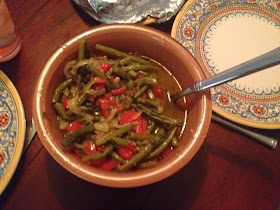My mom used to can with my grandmother. I remember my grandparents had a very large garden, and there were always jars of things in her basement. I'm sure my mom learned what she knows from grandma. I've come to canning only in the last couple of years, and my mom has taught me a lot, but I'm a devotee now. There's no BPA in the containers, there's nothing in the jar I don't know about, and I'm only using the best and freshest ingredients for anything I make.
Yes, this is really old school. Hardly anyone does this anymore, right? Well, does that make it wrong? I take incredible pride in my kitchen, and yes I'm likely a bit off my rocker about it. (Anyone else out there make all their own ketchup, mustard, mayo, that kind of stuff?) But it's just who I am, and it makes me happy. I know my son is getting healthy, real food and he knows where it comes from. (Cleaning fish and rabbits comes a little later, but he'll get there.)
So each year, I put up enough tomatoes to last us through the winter. Sometimes I guess right, and sometimes I'm short and am forced to buy cans in the supermarket. But I think the magic number for my little family of 3 lies somewhere between 20 and 25 quarts of tomatoes for the year. So that was my goal. Yes, that's a lot of work. But when you have a friend to do it with, it goes a lot easier. And, of course, the right Pandora channel playing.
My friend and I figured we'd need roughly 2 1/2 bushels of Roma tomatoes to cover our families, so I picked up 4 boxes of tomatoes.
We collected up all of our quart jars, and had the estimated 4 dozen we'd need. We talked about how to prep jars and lids in a previous post. But please, don't take my word for anything. The USDA publishes guidelines on safe home canning, and you definitely want to review that before you get started. Sterilizing 48 jars, though, was going to be long and tedious to do by boiling them. The alternative approach we did was to put the oven on at 250˚F and leave them in there until we needed them (much longer than 10 minutes). Learned the hard way: Those suckers are going to be hot when you take them out to fill...
To skin the tomatoes, cut out the core, cut a small "x" in the other end, and blanch them in boning water for a couple of minutes (like 2-3, until you just start to see the skin split where you cut it).
Transfer them into an ice bath and let them soak there just until they're cool enough to handle.
After you have the jar packed tight with tomatoes, slide a table knife into the jar along the wall, pushing the tomatoes over to let out any air bubbles. You don't want air trapped between the tomatoes. Leave 1/4" (or a little less) of space at the top of the jar. Wipe the rim with a clean paper towel, and put on your prepared lid and the ring. Submerge the jar into boiling water, and once the water comes back to a boil, start your timer. Leave in the water bath for the recommended time (see above).
The jar needs to cool gradually, so you can either wrap it in a blanket and let it rest overnight, or just turn off the burner on the water bath and let it gradually cool with the water overnight.
The jar should be sealed. Push down on the lid, and if it doesn't click, then it should be sealed. You shouldn't be able to pull the lid off easily, either. Then, one last thing before you put it up. This is a step oft forgotten. Take the ring off. If you leave it on, any tomato bits under the ring will turn into Superglue and make it impossible to take off later. Storing them with lids and no rings is just fine. Oh, and label with the contents and the dates. (I just use a Sharpie on the lid.)
So, four boxes of Romas. What'd we get? It came out to 44 quarts of tomatoes, with about a half a dozen left over. For the extras, I think I'm going to try making my own sun-dried tomatoes. Do I recommend doing 4 boxes of tomatoes all at once?
Let's just say my back really hurts. And our tummies will be happy all winter long.
Next year, I think we'll do two boxes at a time.































